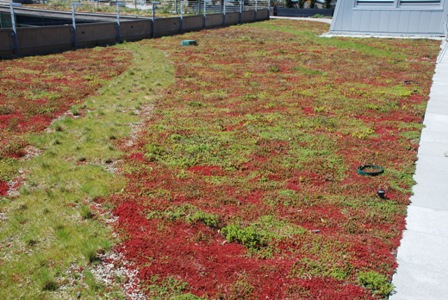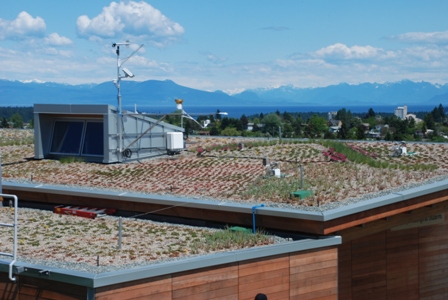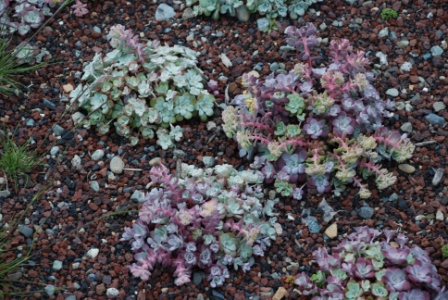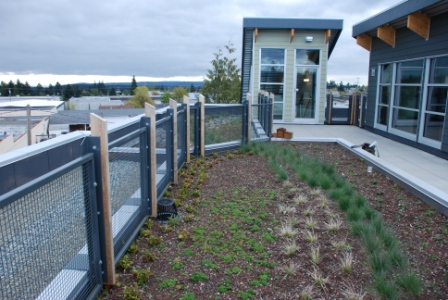|
   
Background
information
What is the objective of the
project?
What type of plants are used on
the roofs?
What type of measurements are
made?
How will these measurements be used?
Back to research
projects main page
------------------------------------------------------------------------------------------------
Background information
Green roofs are engineered roof systems
incorporating the use of vegetation and soil on
conventional roof structures. As stated on
greenroofs.org: "a
green roof system is an extension of the existing
roof which involves a high quality water proofing and root
repellant system, a drainage system, filter cloth, a
lightweight growing medium and plants".
Two types of green roofs are recognized in the literature,
intensive
and extensive, depending on the depth of the planting medium
and the amount of maintenance required. Intensive green
roofs are usually seen as "traditional gardens" and require
a substantial amount of maintenance for irrigation,
fertilisation etc. They also have a deeper soil layer than
extensive roof systems. Extensive green roofs are designed
to be self-sustaining, have a limited soil depth (usually
less than 6 inches) and require maintenance only once or
twice a year for weeding and fertilisation.
Although much work needs to be done to
investigate the environmental, economical and health
benefits associated with green roofs in North America, much
knowledge has been gained from studies in European
countries. In terms of the their
microclimate benefits, green roofs are known to reduce
energy consumption for cooling and heating through improved
thermal performance, reduce temperature extremes of
conventional roof membranes therefore increasing their life
time, and alter the roof microclimate due to the presence of
vegetation and soil which directly contribute to a
reduction in the heat island effect. In terms of their water
management benefits, vegetation and soil associated
with green roofs are known to retain a significant portion
of storm and rain water and lower discharges into municipal
systems. Green roofs have also been shown to improve water
and air quality, allow the development of local agricultural
systems and increase biodiversity of urban habitats. For
more information regarding benefits associated with green
roofs, please visit
greenroofs.org
One of the remaining
unknowns with respect to the use of green roofs in urban
environments relates to their carbon sequestration benefits.
A survey of available literature has revealed that this type
of research is currently lacking. As for any natural
ecosystem, the carbon sequestration of a green roof represents a delicate balance between
three important
physiological processes, carbon assimilation by plant
photosynthesis and carbon release by plant respiration and
microbial decomposition in the soil. Carbon can also be lost through dissolved
organic and inorganic constituents in the water discharge. A
better understanding of the complete carbon balance of green
roofs systems will allow determining if they can be used to
offset carbon emissions from building operations. This has
immense potential to offer mitigation strategies to climate
change from residential, commercial and industrial perspectives.
Top
Ý
------------------------------------------------------------------------------------------------
What is the objective of the
project?
The main objective of the project
is to quantify and model the
performance of extensive green roofs on
Vancouver Island, British Columbia, with respect to their
carbon
sequestration properties. The study is conducted at four
independent locations in the Nanaimo and Duncan regions: (1)
at the Gathering Place of Vancouver Island University (VIU-GP)
(Nanaimo campus), (2) at the VIU Cowichan campus (VIU-COW) in Duncan, (3) at the new office building of
Island West Coast Developments
(IWCD), our
industrial partner, and (4) at the transit building of the Regional District of Nanaimo
(RDN), our municipal partner.
Click on the following images to get a description of each
roof:
Top
Ý
------------------------------------------------------------------------------------------------
What type of plants
are used on the roofs?
A mix of endemic and ornamental plant species have
been planted on the roofs (Table 1). These
plants have been chosen because they are either representative of local
habitats, are low
maintenance and/or resist well to temperature and water
extremes.
Table 1. Example of the most important plant species used on the
green roofs (if species is endemic, click on the species name
to access information on E-flora British
Columbia)
Top
Ý
------------------------------------------------------------------------------------------------
What type of
measurements are made?
VIU-GP is equipped with a permanent and automated
chamber system to monitor the
net carbon dioxide exchange
between the roof and the atmosphere
(click
here to get a full description of the system used on
this roof) while VIU-COW, IWCD and RDN are visited bi-weekly
in summer and monthly in winter with a
compatible portable system. Each roof is
also equipped with an automated climate station to monitor
specific climate variables related to radiation, temperature and
moisture (click on pictures of the sites above to get a description
of the climate stations).
VIU-GP is also equipped with a digital camera to monitor
the phenological development of the roof, i.e. the
vegetation establishment and flowering
patterns over time. Click
here
to see a cool video
from May 2011 to May 2012!
Top
Ý
------------------------------------------------------------------------------------------------
How will these measurements be
used?
The data gathered in this study will
first be used to calculate
the carbon offset potential of the green roofs with respect
to the building carbon emissions. Second, the data related to the roof
microclimate and carbon dioxide exchange properties
will be used to develop and validate a process-based
model of carbon dioxide exchange for the green roofs. This model will
be run with future climate data to evaluate the long-term
carbon sequestration potential of the infrastructure.
Eventually, the model will be tested for other green
roofs in British Columbia and around the world.
Top
Ý |